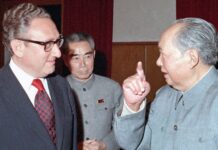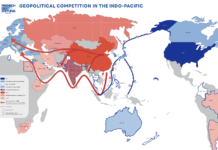Maria Bastos
The study of foreign policy is currently facing important challenges mostly associated with forecasting the world order. Those challenges imply an imbalance between two nexuses operating at different but comparable levels. At the macro-level, the military-economic power nexus occupies the center stage of foreign policy study and decision-making. At the micro-level, it is the human rights-democracy nexus which constitutes problems for the military-economic power nexus. However, in contemporary IR, we are witnessing that the military-economic power nexus continues to manipulate the human rights-democracy nexus to assert its hegemony in a neo-liberal world order. Consequently, existing armed conflicts are likely to perpetuate for longer periods and the potential for new ones to arise increases. Under this scenario, an enquiry into the structures and institutions that construct the military-economic power nexus is urgent, given the rising deterioration of democracy and human rights regimes. An attempt to map out and advocate for a feminist foreign policy must be made because it could contribute towards reducing conflicts. It could also help weaken the prospects of a widening military-economic power nexus, and lead to the promotion of human, women and girls’ rights, and democratic practices.
Foreign policy as a discourse and as a set of practices has been shaped by the individuals who control the sources of political and military power worldwide. Those individuals happen to be men (and women) whose modi operandi have contributed to the production and reproduction of patriarchal structures in societies across the world. In turn, those structures potentiate military and economic power hegemonies, at the expense of human and democratic rights. Consequently, as extensive research has shown, women, girls, and children are, or become the most vulnerable individuals, either in war and conflict scenarios or in regimes where military power spreads through state and society institutions.
Feminist theory, whether as part of social sciences or international studies is not a monolith body of knowledge. It has grown out of diversity, the lives, and indeed the bodies of politically engaged women and men across the world. Questions of gender and gendered relations have either been absent or outright marginalised. However, the past three decades have witnessed a significant shift in the ways feminist theories and gender-based approaches have started a meaningful dialogue with IR and foreign policy approaches. It has been an uphill struggle to bring gender to the centre of mainstream debates in IR. The result is rather positive since the number of panels and sections in international conferences have grown along with peer-reviewed publications in feminist IR and feminist foreign policy domain.
The relevance of a feminist approach to foreign policy and international politics may not be apparent to those trained in conventional approaches within IR and sub-fields. Also, it must be clarified, being a woman does not produce an outright recognition about the need for a feminist approach to IR and foreign policy. In her seminal book, Bananas, Beaches and Bases, Cynthia Enloe asks a question: “where are the women?” This simple question, hitherto erased or deliberately silenced has served as hermeneutical locus from where subsequent relationship started disentangling the gendered ways in which IR and foreign policy have been theorised, taught, and practised. However, an answer cannot be outright obtained. Not because women and girls are not there, but because they have been made invisible.
Enloe’s book is certainly an important beginning to those interested in finding answers, and perhaps to change the ways questions within the discipline are posed and pursued. Being curious, as she often mentions, for instance, about low-secretarial women in foreign offices, or the workers (women and men) at all the Middle Eastern airports, will bring to fore a number of networked questions within which the military-economy power nexus transits and operates. Thanks to the research of Enloe and many other IR and international studies feminists, the hidden reality of a heavily gendered discipline and its associated practices continues to be deconstructed.
One of the most visible results of this long struggle is the institutionalization and implementation of a feminist foreign policy. Since 2015, the Swedish government and its Minister of Foreign Affairs, Margot Wallström became the first member of the international community to be fully committed to advocating and implementing a feminist foreign policy. Foreign policy élites in several countries and also in international organizations have shown a genuine commitment to follow Sweden’s pioneering work. A case in point is Canada where the government of Justin Trudeau has welcomed and accepted pursuing a feminist foreign policy. While not institutionally endorsing a feminist foreign policy, New Zealand’s foreign policy objectives clearly remain committed to it, particularly under the new government of Jacinda Ardern.
Swedish Feminist foreign policy is informed and constituted by reference to two factors. One is a thick ethical component that is derived from and reinforced by concepts such as ‘ethics of care’ and ‘gender cosmopolitanism’, which in turn are constitutive of Sweden’s self-identity. The other is a normative framework derived from the UN Security Council Resolutions on women, peace and security, namely resolutions 1325 and 1888 (the latter carried the strong commitment and endorsement of Hillary Rodham Clinton back in 2009).
In 2018, the Swedish Foreign Affairs Ministry launched the Handbook of Sweden’s Feminist Foreign Policy. The document is a comprehensive guide on what constitutes a feminist foreign policy, and how it can be pursued and implemented through working methods. The Swedish Feminist foreign policy, according to the Handbook, is “a working method and a perspective that takes three Rs as its starting point and is based on a fourth R.” The R’s are Rights, Representation, Resources, and Reality. The target is to enhance and strengthen women and girls’ lives by ensuring these four Rs remain at the core of the government’s policies at local and international level. The whole document provides an outstanding balanced account. Governments willing to adopt and implement this model will be able to end discrimination, gender inequality, and consequently empower women to be active participants in decision-making processes. Particular attention is given to women’s participation in post-war conflict resolution, a theme which has been further developed by the UN Women through a published guide titled Women’s Meaningful Participation in Negotiating Peace and the Implementation of Peace Agreements.
There are two important factors that must be spelt out since they are paramount to validate Swedish Feminist foreign policy’s gender equality perspective and its applicability across continents. Firstly, the Swedish Feminist foreign policy, according to the Handbook “begins and ends with reality.” It states that “the policy shall be based on facts and statistics about girl’s and women’s everyday lives, and shall produce results in people’s lives. Otherwise, it loses its relevance.” Secondly, the policy is based on the key concept of intersectionality that confers it a greater degree of potential for inclusiveness and reflexivity. Intersectionality in feminist theory became a central concept. It signifies that gender as a social category is not, and should not be sought in isolation from other categories like class, race, ethnicity and sexuality. Thus, Swedish Feminist foreign policy, “takes into account the fact that people have different living conditions, levels of influence and needs.”
The institutionalization of Feminist foreign policy by Sweden and by UN Women, with latter dedicating great attention to the Women, Peace and Security (WPS) discourse, has been gaining strength and currency. It has also received criticism particularly on how a feminist foreign policy could contribute to change the tenants of the above-mentioned military-economic power nexus. There are already a couple of results on the table. Sweden has stopped selling weapons to Saudi Arabia after the latter opposed Margot Wallström to speak at the Arab League meeting. Norway has recently halted an arms deal with the UAE, given the latter’s involvement in the Yemen War. WPS at work here. And a recent spat between Canada and the Kingdom of Saudi Arabia has also underscored that a committed Feminist foreign policy can contribute to challenging regimes where human rights are systematically violated domestically and across the border.
In sum, a Feminist foreign policy in the terms proposed by Sweden, constitutes a key step towards the reduction and elimination of gender discrimination, at home and abroad. The vulnerability of women and children intensifies under scenarios of poverty, climate change, conflict, and migration. The scenarios, while for the majority of us, remain locked into the screens of mobile phones and laptops, are the daily reality of millions of human beings. Demanding an end to it is an ethical obligation and a cosmopolitan commitment. Thus, a Feminist foreign policy is a tool and a working plan that can and should be turned into legislation across the world, according to the reality on the ground. It is possible to achieve compelling conflict resolutions, successful disarmament, and strong human rights regimes if states pursue an inclusive foreign policy which is gender-neutral in lingo and is sensitive about promoting the human rights-democracy nexus in tandem with the realist power projections.
Maria Bastos is a PhD Candidate at the DPIR, University of Westminster, UK. She teaches at the School of Governance and Society, UMT, Lahore.

















